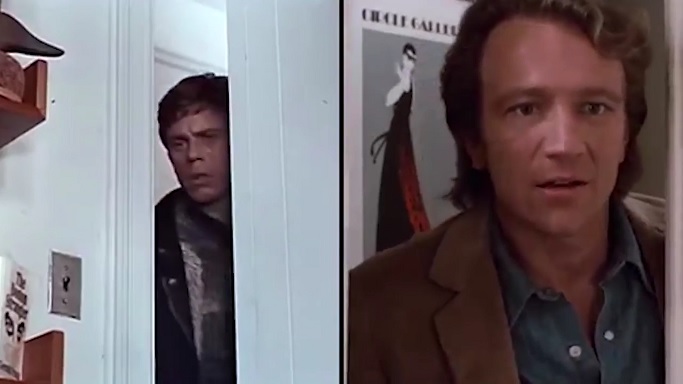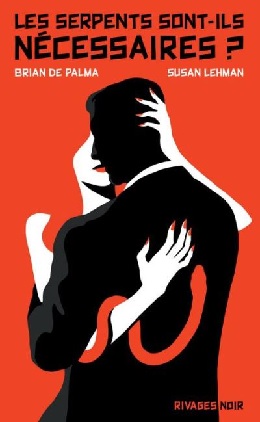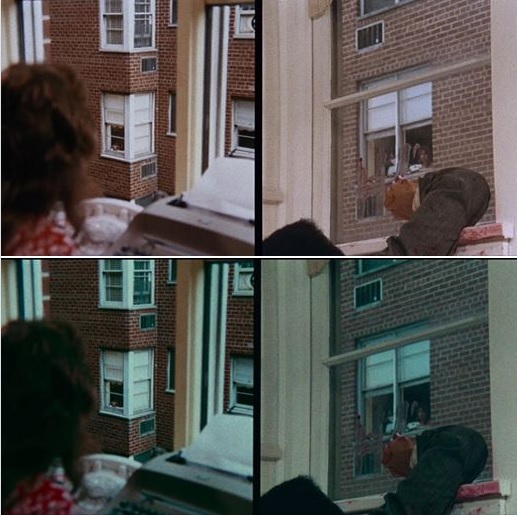NIELA ORR LOOKS AT 40 YEARS OF THE HORROR PSYCHOPATH, "THE GUY WHO WON'T DIE"

Anticipating David Gordon Green's upcoming Halloween, Niela Orr at The Ringer has posted an insightful essay, headlined "The Horror Psychopath in 2018," that looks at the slasher film trope of "the guy who won’t die," introduced 40 years ago in John Carpenter's Halloween:
In the 2018 film, directed by David Gordon Green, Laurie’s a vigilante and a grandmother and Myers is up to the same shit. He’s escaped from the psychiatric hospital again. This is a return to basics, with a crucial and timely update: Myers will be hunting Laurie, but she’s hunting him, too. Their inevitable confrontation will be between two legendary characters and two resistant horror tropes: the “final girl”—or the teenage girl or woman survivor of a horror film—and this other relentlessly alive figure—let’s call him the “guy who won’t die.” Killing him, which Laurie hopes to do, likely won’t be that easy given his track record of being both elusive and durable. The homicidal maniac is a familiar figure in horror: He shows up, stalks female characters, murders with impunity, and usually tricks police departments, private detectives, and his victims’ trusted confidantes into thinking he’s a figment of the victims’ imaginations. He then makes it to the next film and does it all over again. His invincibility is helped along by an infrastructure that disbelieves women. Still we tend to focus on invincibility as a description rather than as a trait. We take the recurring horror psychopath for granted when we see him on-screen; he’s going to come back, so that the films can too.The trope is recognizable to most anyone who’s seen a horror film since the late ’70s: For one reason or another (or for no reason at all), the killer is after babysitters (Halloween) or camp counselors (Friday the 13th), or a group of teenagers with insomnia (Nightmare on Elm Street). The victims fight back with an impressive array of weapons and DIY traps, but it’s never enough. He keeps rising. Every time you think he’s dead, he’s either playing possum or had actually died but was somehow resurrected. This maniacal dude is in diametric opposition to the final girl’s position: He’s engineered the series of torments he subjects her to, while she’s an unwilling participant; he is seemingly infallible while she’s very evidently mortal; he’s implacable, emotionless, and she wears her feelings on her sleeve (until it’s inevitably ripped off). If the final girl is “abject terror personified,” as film theorist Carol J. Clover wrote, this recurring psychopath is the institutionalization of that terror personified. The only thing the two figures have in common is their survival.
Later in the essay, Orr discusses Brian De Palma's Blow Out:
The guy who won’t die seems indestructible. Most often his continued reanimation defies logic. His death-defying Whac-A-Mole pop-ups are mostly meant to keep the jump scares going and lay the groundwork for his eventual reappearance in the series’ next sequel. But his indestructibility also, necessarily, serves as punishment. As Seth Grahame-Smith explains in the genre manual How to Survive a Horror Movie, “Horror movie characters aren’t killed by machete-wielding monsters or reincarnated psychopaths—they’re killed by ignorance. Ignorance of the mortal danger they’re in. Of the butcher lurking in every shadow. Of the new rules. Ignorance of the fact that they’re in a horror movie.” Frailty becomes a justification for his ongoing rage.Fittingly, given how fatal ignorance can be in this medium, the final girl often survives because of her smarts, and—aside from deus ex machina plot machinations and the fact that he needs to survive to keep the story going—it’s not always easy to tell how the guy who won’t die persists. But much of his survival has to do with the fact that he has the upper hand—his victims are on his territory, and they’re playing the game he designed. If the final girl provides “a cathartic end to the gore and gloom,” as Erik Piepenburg’s writes in The New York Times, the guy who won’t die represents the opposite of catharsis. He is an open wound that never heals, a menace who survives from generation to generation, terrorizing a new breed of women and young people who have to learn the rules all over again.
Sometimes making a movie is the best way to critique other ones. Brian De Palma’s Blow Out (1981), about slasher movies and political corruption, is one of the most incisive reviews of the slasher genre, its indomitable attacker, and the guy who won’t die outside of film. In Blow Out, a noir film about making films, John Travolta plays Jack Terry, a sound man for a production company that makes B-movies. When the film starts, Jack’s trying to place a scream in Co-Ed Frenzy, a low-budget slasher film. He ends up getting caught in a political quagmire when a presidential candidate dies in a car accident with a prostitute while he’s nearby recording sound. He rescues and then befriends the woman, Sally (Nancy Allen), who was in the car with the politician, but despite his best efforts to shield and protect her from harm, she dies wearing a wire for him. At the end of the film, still looking for the perfect scream, he uses the one Sally uttered before she died, which is captured on the wire. The last shot of the film is Jack covering his ears as he watches a new version of the film and listens to the overdubbed scream, the blue light emitting from the movie theater washing over him. The most brilliant and insidious thing about that movie is that despite Jack’s misgivings about Sally’s death and the trauma associated with it, he uses her scream anyway. He’s part of the system, and no matter how much he cared for his fallen friend, he chooses to keep making money and retaining his place within it. Despite his proximity to much of the same danger Sally faced, Jack survives, as do the slasher-film psychopaths he helps to foster into the world through his production work, and the political corruption the film critiques. He survives because of the system, which doesn’t explicitly target him. He survives because he knows the old and new rules. He survives because he knows he’s in a horror movie, to echo Grahame-Smith’s calculation.
Horror movies often anticipate our cultural acknowledgement of certain social issues, and in this case, Halloween and the psychopath were able to articulate some of our most common problems long before we had the language ourselves, or while we were developing it. The slasher film’s insistence on men who make rules and traumatize women, and who are still able to continue along in that way, has a brutal corollary in the real world. Men in power, from Bill Cosby to Harvey Weinstein to Les Moonves to Mario Batali and beyond, have consistently exerted their will over women who they think “don’t know the rules” or are ignorant of the fact that they’re in “a guy’s place,” or that they’re in a horror movie. What we as a society have finally begun to acknowledge is that they do know, and always have.
In an interview, John Carpenter explained that his task with the original Halloween was to make an “exploitation horror film,” and part of what makes Laurie Strode’s vigilantism in the 2018 version exciting is that it appears to play up the exploitative qualities of the original film as well as other ’70s movies across genres: the Blaxploitation revenge flicks, the Charles Bronson Death Wish–style swaggering vengeance. The textual elements of gender and violence were already there: the fear and craftiness of final girls and their ilk; the entitlement of the genre’s psychopathic male figures; the gaslighting done by male authority figures; the unfair playing field; the institutional nature of the villain’s terror, which is demonstrated in his continued survival. It will be interesting to see if this year’s Halloween will also exploit the tensions that have ramped up in the #MeToo moment, but which have been pronounced in the culture since at least October 2014, when the Cosby scandal first broke nationwide. In January 2018, Atlantic writer Caitlin Flanagan wrote that “female rage is the essential fuel of #MeToo. Unchecked it is the potent force that will destroy it.” She could have been talking about Carrie White, whom Carol J. Clover called a “female victim-hero,” an archetype who uses feminism and the rage Flanagan mentions to enact revenge on her tormentors. Jamie Lee Curtis draws different inspiration from #MeToo in her portrayal of Laurie, who moves from a quintessential “victim” to a hero in this new Halloween. On Halloween: Unmasked, Curtis talked about her most famous character’s importance in our moment, saying “Laurie Strode could be a #MeToo voice for people who have had violence perpetrated on them. … Laurie Strode’s violence is fake, it’s not real, but in a movie to see a character come around 40 years later and say, ‘No more, #MeToo,’ is powerful.” The patriarchy keeps showing up, like Michael Myers, and the countless copycat characters who have come in his wake. In Halloween, and in Supreme Court confirmation hearings, and in elevators outside the hearings, women aren’t letting these recurring villains thrive without a fight, just as the final girls don’t. But therein lies the biggest difference between the genre and real life: In horror films, there’s only one girl left standing.












 Yonca Talu has a brief review of Brian De Palma and Susan Lehman's novel Are Snakes Necessary? in the September/October 2018 issues of
Yonca Talu has a brief review of Brian De Palma and Susan Lehman's novel Are Snakes Necessary? in the September/October 2018 issues of 


 "I am getting used to the new colors and appreciate the vibrancy and texture," states
"I am getting used to the new colors and appreciate the vibrancy and texture," states